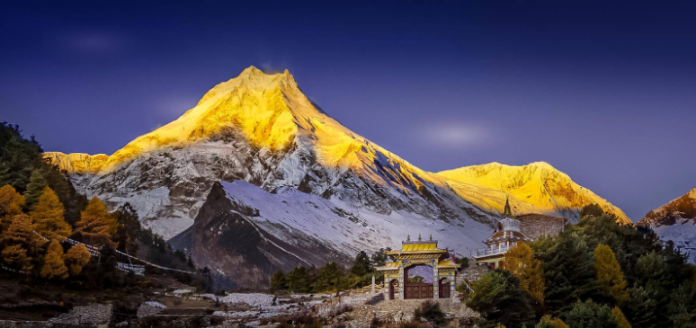The Manaslu Circuit Trek, a remarkable expedition in the heart of the Nepalese Himalayas, offers a profound alternative to the more heavily trodden paths of the Everest and Annapurna regions. This journey, which was only opened to trekking in 1991, circles the formidable Mount Manaslu—the world’s eighth-highest peak at 8,163 meters—and takes adventurers through a diverse and culturally rich landscape that feels wonderfully preserved from the outside world. It is a trek that challenges the body and nourishes the soul, providing an authentic glimpse into high-altitude life, ancient traditions, and raw, untamed natural beauty.
The Landscape of Diversity
The Manaslu Circuit is a tapestry of varied terrain and ecosystems, transitioning dramatically over its 177-kilometer length. The trek begins in the lower, sub-tropical regions of the Gorkha District, where lush green terraced fields and dense forests of rhododendron and pine create a vibrant, oxygen-rich environment. As the trail ascends along the roaring Budhi Gandaki River, the scenery transforms. The deep river gorge, with its numerous suspension bridges, gives way to a more temperate zone of alpine meadows and smaller villages. Higher still, the landscape becomes starker, a high-altitude desert reminiscent of the Tibetan plateau, with a permanent snowline beginning around 5,000 meters. This rapid ecological shift is a core highlight, showcasing Nepal’s incredible biodiversity, from elusive wildlife like the snow leopard and Himalayan tahr to a myriad of plant species.
A Deep Dive into Tibetan Culture
One of the most compelling aspects of the Manaslu trek is its profound cultural immersion. The trail follows an ancient salt-trading route, connecting the lowlands of Nepal with the high-altitude settlements near the Tibetan border. The villages, such as Samagaon, Lho, and Samdo, are predominantly inhabited by ethnic groups of Tibetan origin, including the Nubri and Tsum people. Their lifestyle is a living museum of Tibetan Buddhist traditions, with a palpable sense of community and spirituality. As trekkers pass through these hamlets, they are greeted by an abundance of Mani walls, prayer flags fluttering in the wind, and centuries-old monasteries and chortens. The warm hospitality of the locals, who often welcome trekkers into their basic but cozy teahouses, provides an intimate and unforgettable cultural exchange, a world away from the commercialism found on other popular routes.
The Pinnacle: Larkya La Pass
The climax of the Manaslu Circuit is undoubtedly the crossing of Larkya La Pass. At a formidable elevation of 5,106 meters (16,752 ft), this pass is a significant physical and mental challenge. The approach to the pass is a test of endurance, requiring an early start and a slow, steady ascent in cold, thin air. The effort is rewarded with a truly breathtaking panorama. From this high vantage point, a sea of snow-capped peaks unfolds in every direction, including the towering Himlung Himal, Cheo Himal, Kang Guru, and a commanding view of Manaslu itself. The descent from the pass is equally demanding, leading trekkers down into the beautiful and serene Bhimthang valley, a reward for the arduous climb.
Challenges and Preparation
The Manaslu Circuit is a demanding trek, classified as challenging due to its high altitude, rugged terrain, and remote location. Physical fitness is paramount. A training regimen focused on cardiovascular endurance, leg strength, and stamina is highly recommended. Trekkers must also be mentally prepared for long hiking days, significant elevation gains, and the potential for altitude sickness. Proper acclimatization is not just a suggestion but a critical safety measure, and most well-planned itineraries include rest days at strategic points to allow the body to adjust.
Furthermore, the remote nature of the region means that infrastructure is basic. Teahouses offer simple food and accommodation, but trekkers should be prepared for limited amenities. Required trekking permits, including the Restricted Area Permit, the Manaslu Conservation Area Permit (MCAP), and the Annapurna Conservation Area Permit (ACAP), must be obtained through a registered trekking company in Nepal, which also necessitates a group of at least two trekkers and a licensed guide.
The Best Time to Trek
The ideal seasons for the Manaslu Circuit Trek are Autumn (September to November) and Spring (March to May). Autumn offers stable weather, clear skies, and spectacular mountain views in the crisp, post-monsoon air. Spring brings blooming rhododendron forests and warmer temperatures, painting the landscape in vibrant colors. While it is possible to trek during the monsoon (June to August) or winter (December to February), these seasons present added challenges of slippery trails, landslides, extreme cold, and snow-blocked passes, making them less suitable for most trekkers.
Conclusion: Key Takeaways
The Manaslu Circuit Trek is more than a hike; it is an expedition into the profound. It stands as a testament to the wild, untouched beauty of the Himalayas and the resilient spirit of its people.
- A Less-Crowded Alternative: It offers a more authentic and solitary experience compared to more popular routes, allowing for a deeper connection with nature and local culture.
- Cultural Immersion: The trek provides a unique opportunity to experience living Tibetan-influenced communities, their ancient traditions, and welcoming hospitality.
- Physical and Mental Challenge: The journey is physically demanding, culminating in the high-altitude Larkya La Pass, a formidable yet incredibly rewarding achievement.
- Unparalleled Scenery: The trek’s diverse landscapes, from lush sub-tropical forests to barren alpine deserts, are a feast for the eyes, offering a visual journey unlike any other.
- Proper Planning is Essential: Due to its remote nature, the trek requires mandatory permits and a licensed guide, underscoring the importance of professional organization and preparedness for a safe and successful journey.

